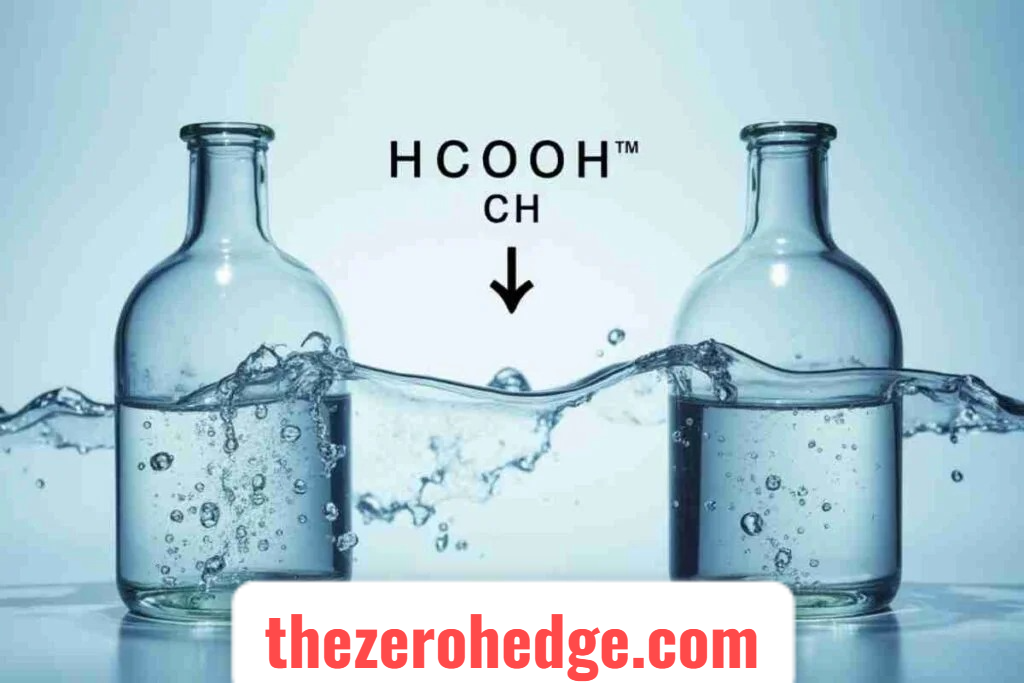
If you’ve ever stumbled across the chemical term HCOOCH CH₂ H₂O, you’re not alone. At first glance, it looks complex—but this compound leads us to one of the key intermediates in organic chemistry: Methyl formate, a simple ester formed through esterification of formic acid and methanol. When combined with water (H₂O) and CH₂ groups, its role expands into numerous fields including fuel additives, solvents, and even polymer synthesis.
This article will explore its molecular composition, the reaction mechanism, and its various industrial applications. We will also discuss how its chemistry connects with concepts such as nucleophilic substitution, proton transfer, and redox cycling.
Breaking Down the Molecular Composition
The molecular arrangement of HCOOCH CH₂ H₂O stems from three central components: formic acid (HCOOH), a CH₂ group, and water (H₂O). This combination leads us to a reaction path often associated with methyl formate, a compound formed by linking formic acid with methanol through an ester bond.
The structure holds an ester functional group, often represented as R-COOR’. The presence of the CH₂ group introduces reactivity potential, especially when combined with water, making hydration/dehydration and condensation reactions possible.
Chemical Structure and Key Bonds

The central piece, methyl formate, features an ester bond that is susceptible to nucleophilic attack. When placed in an aqueous environment, the molecule may undergo hydrolysis, breaking back down into methanol and formic acid under the presence of an acid catalyst like sulfuric acid.
| Component | Function |
| Formic Acid | Reactant, part of ester group |
| Methanol | Reactant, forms ester with acid |
| CH₂ group | Linker, provides reactive position |
| Water | Drives hydrolysis or condensation |
This reaction proceeds via a tetrahedral intermediate and involves proton transfer, shifting the balance towards product or reactants depending on reaction equilibrium and reaction kinetics.
Reaction Mechanism Overview
The process begins with a nucleophilic substitution, where the oxygen from methanol attacks the carbon of formic acid. This leads to an unstable tetrahedral intermediate, which collapses to form the ester and water. Under acid-catalyzed conditions, the proton transfer helps stabilize the molecule.
In the reverse process, hydrolysis occurs when water attacks the ester, again via a tetrahedral intermediate, breaking the bond and releasing formic acid and methanol. These are standard processes used in both laboratory and industrial-scale reactions.
How Hydrolysis Shapes Reactivity
Hydrolysis of methyl formate is a well-studied reaction. It is catalyzed by acids and involves cleavage of the ester bond by water. The reaction equilibrium in this process can shift with changes in temperature, catalyst concentration, or solvent polarity.
This makes it an ideal candidate for industries that need solvents, mild acids, or sources of hydrogen donors in controlled chemical environments. The hydrolytic process is also important for understanding green chemistry pathways that reduce environmental harm.
Industrial Applications and Uses
The compound and its derivatives are widely used in real-world industries:
- Solvents in paint and coatings
- Fuel additives in combustion engines
- Polymer synthesis as chemical precursors
- Green chemistry due to low toxicity
- Catalytic reduction in hydrogenation systems
The flexibility of this chemical structure allows for multiple transformations, making it valuable in synthetic routes for pharmaceuticals and biofuels alike.
Laboratory Synthesis and Control
The synthesis of methyl formate via esterification is usually done using acid-catalyzed reactions, often involving sulfuric acid. Control over temperature and pH is critical, as even slight deviations can affect reaction kinetics and final yield.
Basic Laboratory Procedure:
- Mix formic acid and methanol
- Add a few drops of sulfuric acid
- Maintain at ~60°C with stirring
- Use a water trap to collect methyl formate
Careful steps ensure high purity and reduce unwanted side reactions, making the compound more useful in downstream processes.
Environmental Considerations
Green chemistry focuses on minimizing waste, toxicity, and environmental damage. HCOOCH CH₂ H₂O and its related reactions are often aligned with these goals. Using acid-catalyzed reactions and avoiding heavy metals reduces ecological burden.
Also, due to the volatile nature of methanol and formic acid, handling must be done under fume hoods or sealed systems. This improves worker safety and minimizes exposure.
Safety and Handling Protocols
Despite its beneficial uses, caution must be exercised:
- Methyl formate is flammable and irritant
- Methanol can be toxic if inhaled or ingested
- Sulfuric acid is corrosive
- Protective gloves, goggles, and lab coats are essential
- Ensure proper ventilation during synthesis
Understanding these hazards is crucial in both labs and factories where these reactions are scaled up.
Fuel Applications and Hydrogen Economy
Methyl formate can act as a hydrogen donor, making it useful in fuel cells and hydrogenation reactions. Its decomposition releases formic acid, a compound considered for fuel additive formulations due to its clean-burning nature.
This fits well into the future energy mix where efficient, low-emission fuels are required. Hydrogen produced from such reactions is easier to store and transport than pure hydrogen gas.
Role in Polymer and Material Synthesis
In polymer synthesis, compounds like methyl formate serve as monomer stabilizers or precursors. Their low boiling points and solubility in organic solvents allow them to be easily removed or recycled during manufacturing.
This contributes to sustainable material science by reducing waste and enhancing product durability, especially in coatings, resins, and flexible materials.
Reaction Kinetics and Control Factors
The reaction kinetics of esterification and hydrolysis are influenced by:
- Temperature (higher speeds up reaction)
- Acid/base concentration (affects equilibrium)
- Solvent properties
- Reactant ratio (drives equilibrium)
- Stirring and contact time
Controlling these ensures optimal production of methyl formate and derivatives.
Visualizing the Chemical Behavior

Imagine this compound like a seesaw. On one side, you have esterification, on the other, hydrolysis. Whether it tips left or right depends on the reaction equilibrium and external factors.
Here’s a quick summary:
| Reaction Type | Catalyst | Outcome |
| Esterification | Sulfuric acid | Forms methyl formate |
| Hydrolysis | Acid/base | Yields methanol + formic acid |
Both reactions offer educational value and industrial significance, highlighting the balance of chemistry in action.
Emerging Research Areas
Modern research now focuses on:
- Enhancing reaction kinetics with greener catalysts
- Using methyl formate in fuel cells
- Leveraging its redox cycling in bio-chemical pathways
- Designing solvents for sustainable processes
These breakthroughs support the transition to green chemistry and next-gen energy sources.
Conclusion
The compound HCOOCH CH₂ H₂O, closely tied to methyl formate, embodies simplicity and versatility. It brings together fundamental chemistry principles like nucleophilic substitution, proton transfer, and reaction equilibrium into one reactive framework. From acid-catalyzed reactions to fuel additives, its utility is widespread and growing.
Its use in polymer synthesis, catalytic reduction, and green energy makes it a cornerstone of modern chemical research. By understanding its chemical structure and mastering its reaction mechanisms, we unlock possibilities that are safe, sustainable, and efficient.
Frequently Asked Questions (FAQs)
1. Is HCOOCH CH₂ H₂O a real compound or notation?
It represents a structural shorthand combining methyl formate, a CH₂ group, and water—useful in studying hydrolysis and condensation reactions.
2. Why is methyl formate important in industry?
Methyl formate serves as a solvent, fuel additive, and base for polymer synthesis, offering both efficiency and lower toxicity.
3. How is hydrolysis of methyl formate controlled?
By using acid catalysts like sulfuric acid and adjusting reaction conditions, the process can be driven toward either formation or breakdown.



